Sabina Murray’s seventh book, The Human Zoo, is set in present-day Manila under the terrifying reign of a Rodrigo Duterte-like dictator. Part action thriller, part romance, and part family saga, the novel was inspired by an article Murray wrote for VICE magazine in 2017 about Duterte’s popularity, despite his brutal policy of extrajudicial killings that has claimed thousands of lives.
Murray grew up in the Philippines and Australia and is of mixed heritage. She won the PEN/Faulkner Award for The Caprices, a collection of short stories set during the Pacific campaign of the Second World War. Her other books include Valiant Gentlemen, Tales of the New World, Forgery, A Carnivore’s Inquiry, and Slow Burn. She is currently working on Vanishing Point, a book of gothic short stories. She teaches creative writing at the University of Massachusetts Amherst.
I spoke to Sabina Murray about the role of humor in her work, the genesis of The Human Zoo, and the book’s connection to her first novel, Slow Burn, which is also set in upper-class Manila but during the Ferdinand Marcos regime.
***
The Rumpus: The main character of The Human Zoo, Christina (Ting) KIein, is a Filipino American journalist who has written an article about the Philippines for VICE magazine and returns home to research a biography of Timicheg, an indigenous Filipino brought to America at the start of the twentieth century to be exhibited as part of a human zoo. Like Ting, you wrote an article about Duterte in VICE in 2017. When did you decide to write a novel based on your experience?
Sabina Murray: I wasn’t even planning to write The Human Zoo. The book I always thought I was going to write was going to be some kind of multi-generational saga. That’s where I thought I was headed at some point during my career. But then I was contacted by VICE, pitched an article about Duterte’s popularity, and went back to the Philippines. The reason I pitched the article was to understand why Duterte was so popular.
When I travel back to the Philippines, I go to spend time with my family. I hadn’t spent much time focusing on the political situation or people beyond my family circle, so it was really interesting for me to actually go and talk to people from different walks of life—people whose experiences were different than mine, people who are both pro and anti-Duterte. Those stories are what sat in my head after the article was published. I knew there was a book in there somewhere.
I struggled with whether or not I was the correct person to write such a book. The Philippines has a lot of really great writers who are no doubt focusing in on Duterte. I can’t write the book that will best explain what is happening in the Philippines or what it’s like to live under that regime, but I can write a book that is deeply in my perspective, which is what it’s like to watch people affected by that regime.
Also, I read War and Turpentine by a Belgian author, Stefan Hertmans, which is set in Ghent and deals with a grandfather’s memories of World War I. In that book, the character of Timicheg makes an appearance, because Ghent was where he was abandoned by his handler. It’s where he died and was memorialized. They named an underpass for him there. I found that so bizarre. I knew generally about the human zoos and how indigenous Filipinos had been brought to America and Europe in the early twentieth century as “entertainment.” I hadn’t really delved into the subject until reading that book. Those two things—the VICE article and encountering the life of Timicheg—were what made me want to write this book.
Rumpus: It seems like you wrote The Human Zoo quickly. What was the process like of actually writing the book?
Murray: It’s funny because I look at this book now and I can see what I did and I am proud of it. But when I was writing it, I had never written a book that I felt less like writing. I was occasionally excited by the writing, but this was a real seat-of-the-pants to the seat-of-the-chair and “give yourself three hours a day and don’t get up until you have three or four pages” kind of process.
I wanted to write a political novel, but I also wanted to incorporate elements of romance, thriller, or just a companionable story about someone returning home. I didn’t want it to be heavy-handed or didactic. I didn’t want to make it seem like people were eating their vegetables by learning about people suffering. I was in a hurry because I felt like if there are people who are going to be moved and interested in the Philippines because of this book, it needs to come out when it’s fresh.
Rumpus: Is there any connection between The Human Zoo and your first novel, Slow Burn, which was set in Ferdinand Marcos-era Manila? Both have female protagonists of mixed heritage who are members of Manila society. Isobel in Slow Burn is a party girl in her early twenties, and Ting, who is in her forties, is also a member of the upper crust in the Duterte era, even though Duterte is never named.
Murray: When I was writing The Human Zoo, I thought, “Am I writing Slow Burn again as an older person?” I was a little paranoid, so I asked my older son if that was true. He said, No, it’s not. You do have the dictator Marcos in Slow Burn, and Duterte in The Human Zoo. I was aware of that, but I think that The Human Zoo for me is more about grappling with writing about a place that is so significant in my makeup, a place where I haven’t lived in many years. I wanted to be respectful of my perspective, of owning my perspective as outsider/insider, rather than claiming to know what it is like to live there. It is the only perspective from which I really feel comfortable writing for the Filipino people. I should clarify that I don’t think this book is only for the American audience. I think the readership is broader than that.
Isobel in Slow Burn is really young, nineteen or twenty. Ting is a middle-aged woman returning home to Manila after her marriage has ended. So there’s a great distance between those characters. Also, I don’t expect people to have read a book that came out so long ago! I sold Slow Burn when I was twenty. I remember, because I couldn’t legally sign a contract. I signed a provisional contract and then finished it up when I was twenty-one. So, that was thirty-three years ago. Is my math, right?
Rumpus: Your math is right! I read in an interview where you said The Human Zoo went through many revisions. I was wondering if you could describe the process and if it was different than the other books you have written.
Murray: It was definitely different. I wrote it in a hurry. The book came in at three-hundred and forty manuscript pages. It needed to be about 220 manuscript pages, which is around three-hundred book pages—now they make all books three hundred pages. I needed to lose a lot.
I am such a research junkie. I just love it. And the historical sections were really, really long. Like the Battle of Caloocan [during the Philippine-American War which was fought between 1899 and 1902], which is described in maybe eight hundred or a thousand words in the book. Before, it was a good ten pages. The short section on how the Filipino people took in Jewish refugees during the Second World War—that was five or six pages. Now it’s much shorter and incorporated into the poker scene.
I have a very good content editor, Katie Raissian. She told me that the manuscript needed work. She asked questions about the research-heavy sections: “Why are we learning all this information now?” My answer was, “Well, we’re learning about it because it’s interesting.” I realized that the information needed to serve the story. So, I ruthlessly cut those sections back. I also put more introspection in Ting so she wouldn’t ring so shallow. She was much more shallow in the first version. She’s not exactly the most the realized individual now, but earlier she was a very smart, ditzy person.
I was also looking to find inspiration in other literary thrillers that pinpoint a culture or just hold it up and make it really sing. I looked at Graham Greene’s The Quiet American, which of course is problematic, because none of the Vietnamese people speak. But that was inspirational in a way too. What if the locals were speaking? What if the Messianic presence that comes back to save the country isn’t a white savior, but somebody of Filipino background? Like the character of Laird in my novel, who is the fiancé of Ting’s cousin. When you take race out of it, how do these pieces move in a different way?
The Quiet American is not a long book, it’s like a long short story. I thought that if I just could get the manuscript down to the length of The Quiet American, it would be amazing. But I couldn’t do it. I did lose over a hundred pages of the first draft. After that, I felt much better.
Rumpus: That’s interesting. With your other books what was the editing process like?
Murray: Well, Valiant Gentlemen, which is around five hundred pages, was seven hundred pages at the beginning. It was too long. It was a baggy monster. When I cut down Valiant Gentlemen, there was only one section where I took out more than ten pages together. The rest of it was peeled out of paragraphs, shortening sentences—I went through the whole book and just shrunk it. And that process was like sticking a pin in my eye. It was horrible.
I don’t know if I actually like editing. It’s like a really hard yoga workout. Do I like that? But when it’s over, I feel amazing. So, I think I might like it in a way. Before that, I had my short story collections [The Caprices and Tales of the New World]. My short stories are so weird. When it comes to editing, nobody really edits them. Even my editors, who are usually all over me to cut stuff in my novels, say, “Huh, this is interesting.” But with a novel though, my God, they’re brutal. They roll up their sleeves, and they just come at me. I’m always happy for it.
The editor who cares is the one who will rip your book to pieces, unfortunately. And if you’re not willing to see that, you might be really missing opportunities. Agents and editors are not the enemies of literature. They have interest in making it good. They don’t become editors and agents because they love money.
Maybe some people write perfect books the first time, but I’m not one of them. I’ve written so many books. Part of that is because I send them out there and have help fixing them. They end up in the public sphere because I have help getting them there.
Rumpus: You describe The Human Zoo as part thriller and romance and different genres, but I want to talk about how funny it is and the role humor has in it. When I was reading it, there were so many passages where I laughed out loud.
Murray: For a book that’s about such a scary time in the history of the Philippines, there’s some things you have to do to make it work. If you want people to be really upset in a book, to have them feel something to their core, you need to make them laugh so that you give them the experience of emotion. If you really want to make someone cry, you have to make them laugh. It’s a kind of cathartic experience for the reader. Even if they don’t know why they like it—they’re laughing, they’re crying, they’re all over the place—it feels weirdly good.
The other thing is that Filipinos are funny. Ultimately, I wanted to be honest to these people, because they’re so resilient. Filipinos are very happy to be Filipinos. They think they’re very lucky because they have family and good food and good humor. That’s enough for a lot of my countrymen. It’s also based in tremendous resilience. When you’re faced with multiple waves of colonization—the invasion by the Japanese, the Americans, the Spaniards before that—and then a volcano erupts, there’s a tsunami and an earthquake. The pandemic arrives, you’re under the rule of this crazy dictator. All of these awful, awful things. The Filipinos use their humor as a form of resilience. And it’s almost like not being resilient is seen as strange.
I remember when The Caprices came out, which was my book about the Pacific Campaign of the Second World War, I went home to the Philippines, and I was talking about it to my Tia, who lived through the war. She said, “Wow, Sabina, you were really affected by the Second World War.” Which is so crazy. I told her, “These are your stories. You gave them to me.” Obviously, I was affected by a war I never experienced. I wrote a book about it. My relatives just kept going. Your people are killed and your cities put to rubble. You still have to get up, send your kids to school, earn money and have somewhere to bring your family together. So, I think that’s where a lot of the humor is anchored. You can sense the resilience, the strength, that Filipino way of being through their jokes. I didn’t conjure these characters out of nowhere. They are funny.
Rumpus: The dark humor definitely comes through in the book. I also love how you intersperse the Tagalog in the book without putting it in italics. It seems very natural. Is that something you thought about or did it just come out that way?
Murray: It’s something I thought about. We have permission to not explain things as writers who interact with cultures that are not American normative, English-speaking. And the thing is, people actually do know how to read that way. When you’re reading A Portrait of the Artist as a Young Man or something like that, and all of a sudden there’s Latin and French there. Or you’re reading Magic Mountain, and it switches to French. I don’t speak French. You’re just supposed to put up with it. I was recently reading The Pursuit of Love [by Nancy Mitford], just fun, summer reading. Because it concerns the English aristocracy between the wars, they are always throwing French sentences in there. I don’t know what they mean. We’re trained to do that with European languages.
I have to tell you that my agent, my editors, nobody pushed back on the fact that I didn’t want to italicize and didn’t want to translate the Tagalog. In fact, they all said, This is great, it looks real. There was no fight it at all. The one little thing I got was from the copy editor, who flagged the use of the Tagalog word for big sister, ate. I didn’t change it. In terms of craft, of point of view, Ting, the narrator, is not going to be thinking of explaining that “ate” is the Tagalog word for big sister and not “ate,” the verb in English. That’s a point of view violation. You leave the words like that for logic, not just for cultural pride. Also, readers can look things up so easily. There’s no excuse.
Rumpus: I have to ask about the cover of The Human Zoo. The image of the woman is so striking. Can you tell me a bit about it?
Murray: When I was trying to figure out how to do this book, I went to see a Filipino artist’s exhibition right by the Highline in New York. The artist was Ronald Ventura. There was a painting that took up almost an entire wall called Party Animal. I just loved it. There’s a scene in the book where a version of the painting makes an appearance. I shrunk the painting down since there’s no way Party Animal could be hung on an apartment wall.
I wanted Party Animal for the book cover but it just didn’t work with the book designers. They tried to hone in on one of the creatures in Party Animal, but that didn’t work either because of the confetti in the painting. I fall in love with things. But I know that the book designers are hired because they’re good at their job and you have to listen. You have to take your little pet desires away and let people do their job.
The painting they came up with is by the same artist. And everything works. The colors really spoke to me—the orange and black. There’s something in the slow heated mess of the book that is really evoked in the work. It’s also just a beautiful image.
***
Photograph of Sabina Murray by Aysegul Savas.





